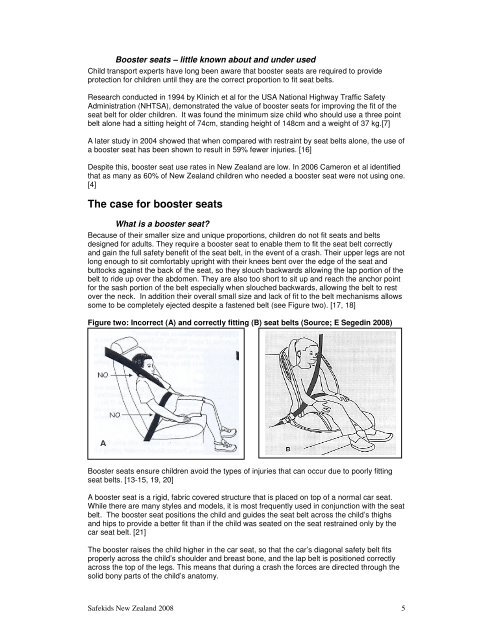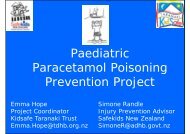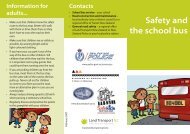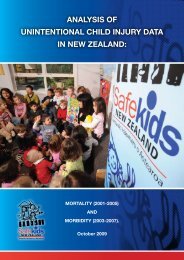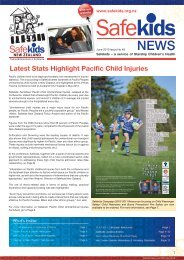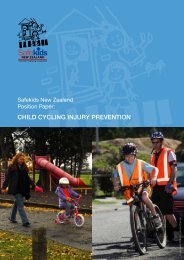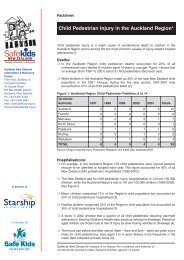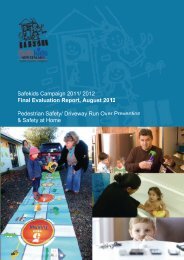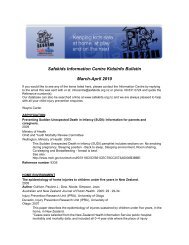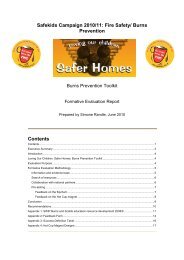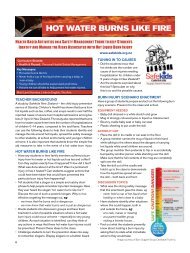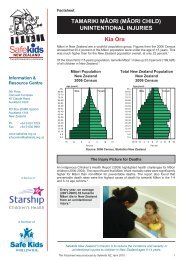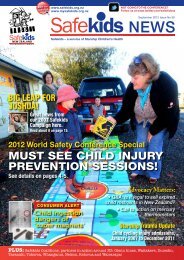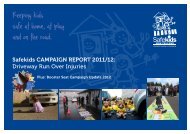Summary It's booster seat time for Kiwi kids - Safekids
Summary It's booster seat time for Kiwi kids - Safekids
Summary It's booster seat time for Kiwi kids - Safekids
Create successful ePaper yourself
Turn your PDF publications into a flip-book with our unique Google optimized e-Paper software.
Booster <strong>seat</strong>s – little known about and under used<br />
Child transport experts have long been aware that <strong>booster</strong> <strong>seat</strong>s are required to provide<br />
protection <strong>for</strong> children until they are the correct proportion to fit <strong>seat</strong> belts.<br />
Research conducted in 1994 by Klinich et al <strong>for</strong> the USA National Highway Traffic Safety<br />
Administration (NHTSA), demonstrated the value of <strong>booster</strong> <strong>seat</strong>s <strong>for</strong> improving the fit of the<br />
<strong>seat</strong> belt <strong>for</strong> older children. It was found the minimum size child who should use a three point<br />
belt alone had a sitting height of 74cm, standing height of 148cm and a weight of 37 kg.[7]<br />
A later study in 2004 showed that when compared with restraint by <strong>seat</strong> belts alone, the use of<br />
a <strong>booster</strong> <strong>seat</strong> has been shown to result in 59% fewer injuries. [16]<br />
Despite this, <strong>booster</strong> <strong>seat</strong> use rates in New Zealand are low. In 2006 Cameron et al identified<br />
that as many as 60% of New Zealand children who needed a <strong>booster</strong> <strong>seat</strong> were not using one.<br />
[4]<br />
The case <strong>for</strong> <strong>booster</strong> <strong>seat</strong>s<br />
What is a <strong>booster</strong> <strong>seat</strong>?<br />
Because of their smaller size and unique proportions, children do not fit <strong>seat</strong>s and belts<br />
designed <strong>for</strong> adults. They require a <strong>booster</strong> <strong>seat</strong> to enable them to fit the <strong>seat</strong> belt correctly<br />
and gain the full safety benefit of the <strong>seat</strong> belt, in the event of a crash. Their upper legs are not<br />
long enough to sit com<strong>for</strong>tably upright with their knees bent over the edge of the <strong>seat</strong> and<br />
buttocks against the back of the <strong>seat</strong>, so they slouch backwards allowing the lap portion of the<br />
belt to ride up over the abdomen. They are also too short to sit up and reach the anchor point<br />
<strong>for</strong> the sash portion of the belt especially when slouched backwards, allowing the belt to rest<br />
over the neck. In addition their overall small size and lack of fit to the belt mechanisms allows<br />
some to be completely ejected despite a fastened belt (see Figure two). [17, 18]<br />
Figure two: Incorrect (A) and correctly fitting (B) <strong>seat</strong> belts (Source; E Segedin 2008)<br />
A<br />
Booster <strong>seat</strong>s ensure children avoid the types of injuries that can occur due to poorly fitting<br />
<strong>seat</strong> belts. [13-15, 19, 20]<br />
A <strong>booster</strong> <strong>seat</strong> is a rigid, fabric covered structure that is placed on top of a normal car <strong>seat</strong>.<br />
While there are many styles and models, it is most frequently used in conjunction with the <strong>seat</strong><br />
belt. The <strong>booster</strong> <strong>seat</strong> positions the child and guides the <strong>seat</strong> belt across the child’s thighs<br />
and hips to provide a better fit than if the child was <strong>seat</strong>ed on the <strong>seat</strong> restrained only by the<br />
car <strong>seat</strong> belt. [21]<br />
The <strong>booster</strong> raises the child higher in the car <strong>seat</strong>, so that the car’s diagonal safety belt fits<br />
properly across the child’s shoulder and breast bone, and the lap belt is positioned correctly<br />
across the top of the legs. This means that during a crash the <strong>for</strong>ces are directed through the<br />
solid bony parts of the child’s anatomy.<br />
Safe<strong>kids</strong> New Zealand 2008 5


